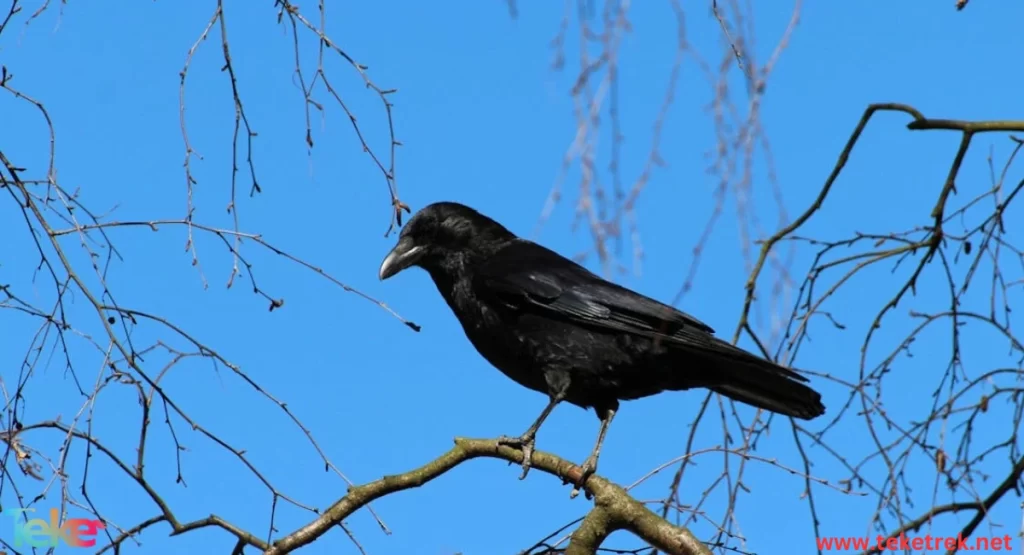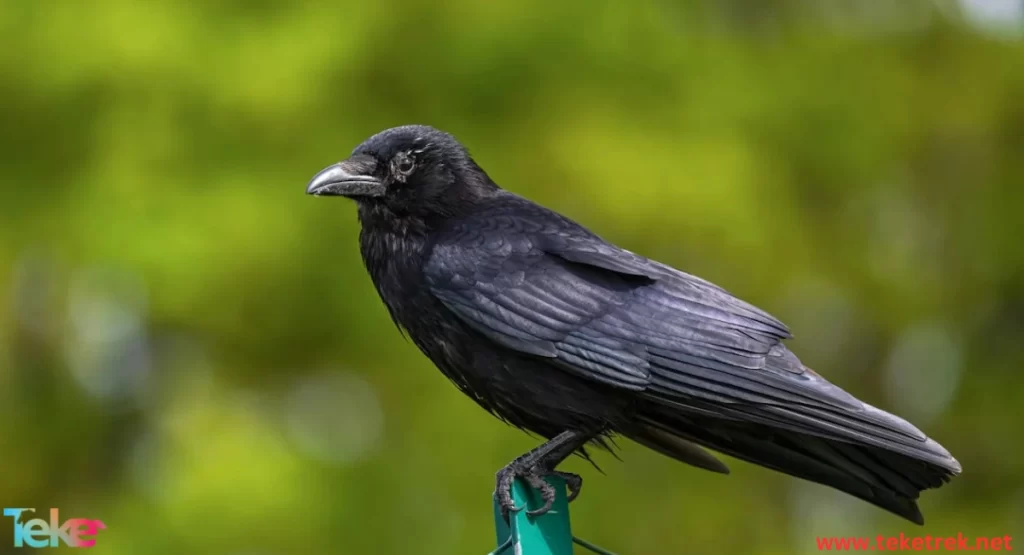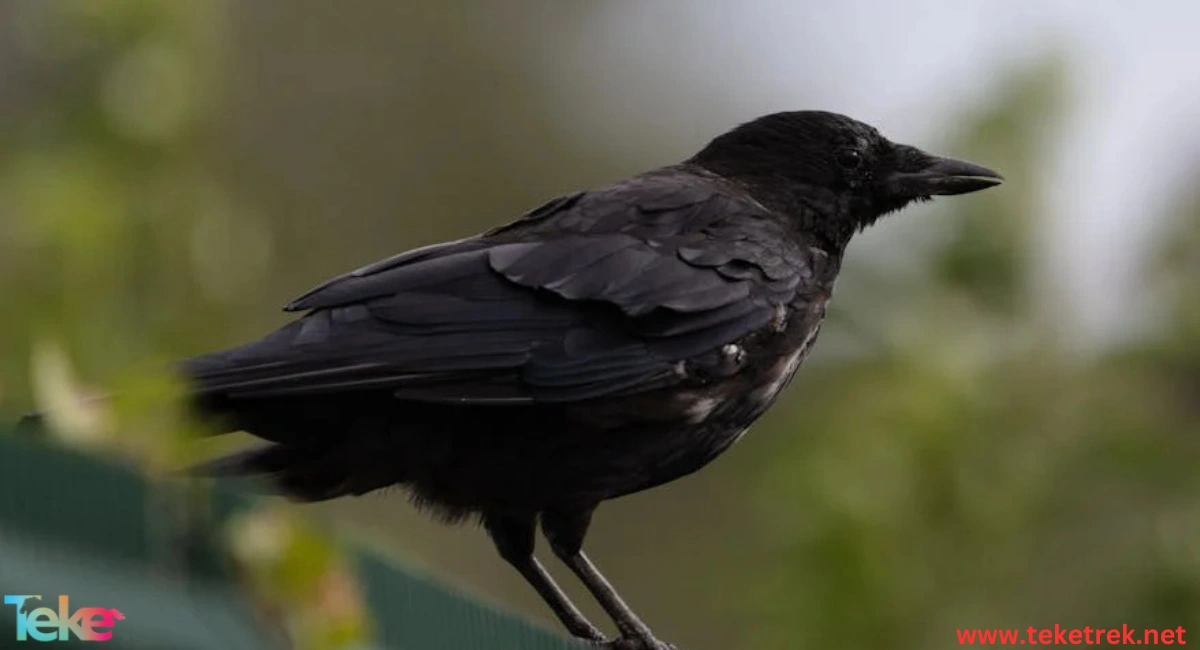It belongs to the class Aves, family Corvidae.
The Common Raven is one of the most famous birds in the popular culture of many civilizations.
Let’s learn more about him from teketrek.
Facts about The Common Raven
In English folklore, it is said that the raven visits hell in midsummer every year and presents a group of its feathers to the devil.
The Common Raven is considered a bird of omen.
The Greeks did not allow it to be placed in temples because of this, believing that the descent of the Common Raven to a house is a sign of death.
Some Chinese myths say that the Common Raven has three legs and lives in the heart of the sun.
Its legs represent different times of the day: morning, noon, and evening.
The Common Raven has many distinctive characteristics that set it apart from other birds.
The Common Raven is a very intelligent bird. It is attracted to shiny objects like accessories, gold, and silver, so we often see shiny objects and pieces of soap in a raven’s nest.
A Common Raven will kill any raven that contracts a contagious disease to prevent the infection from spreading to itself or other birds.
The Common Raven is known for its loud call, known as “croaking,” which most people consider ominous.
It is also known for being aggressive and fierce.
When a member of a group of Common Ravens dies, the other birds stand in what resembles mourning, then gather to find out the cause of death.
The Common Raven can produce a large number of calls.
Scientists refer to this as their communication language, as ravens use this sound to ward off cats, owls, and humans.
One of the most surprising behaviors of this bird is its court system, where the raven community tries any individual who breaks the rules.
In cases of rape or destruction of a nest, the raven court requires the offender to build a new nest for the victim.
If a male raven attacks another female raven, the bird court rules that the attacker be beaten to death.

The Common Raven specification
. Color: The Common Raven is characterized by its shiny black color
Raven size: Its weight ranges from 377 grams to 1625 grams. eaching a length of about 69 cm.
Bill, Wings: The Common Raven has a thick, curved bill, with a wingspan of about 4 feet.
Tail: The Common Raven has a tail shaped like a wedge.
Throat: Its throat contains feathers that the bird can raise or lower.
Legs: The Common Raven has long legs that help it in flying and walking.
Age:Common Ravens live for about 13 years and 4 months, with captive birds living longer.
It has been recorded that one captive raven lived for 80 years, and ravens in the Tower of London in England live for 44 years or more.
The Common Raven habitat
The Common Raven lives in various habitats found all over the world.
You can find the Common Raven in mountain forests, deciduous forests, and coniferous forests.
The Common Raven inhabits Northern Europe, Iceland, Asia from the Pacific Ocean to the Himalayas, reaching India and Iran, as well as the Canary Islands.
The Common Raven is present in North and Central America, extending to the southernmost regions.
The Common Raven prefers open wilderness areas such as grasslands, tundra, and somewhat open forests.
What is the Common raven diet?
The Common Raven is known to be a carnivorous bird.
It feeds on small animals, mammals, amphibians, reptiles, and insects.
The Common Raven consumes seeds, fruits, nuts, arthropods, and worms.
The Common Raven scavenges for food and stores it for short or long-term periods in trees.
Reproduction stages of the Common Raven
Courtship displays occur among Common Ravens throughout the year, with more displays in autumn and winter.
Breeding and egg-laying in Common Ravens occur between mid-February and late May, varying by region.
A female Common Raven lays 3 to 7 eggs in each nest and incubates them for about 25 days.
The eggs are pale greenish-blue with brown markings.
The male protects the young by standing over them and feeds the female in the nest.
Common Raven nests are made of sticks and are uneven.
The young leave the nest between 5 and 7 weeks old and can then leave the area.
Threats to the Common Raven
The Common Raven is an intelligent bird, making it difficult for predators to prey on them.
However, owls and birds of prey may steal raven eggs.
Important animals that threaten the Common Raven include eagles, horned owls, red-tailed hawks, and wolves may chase ravens.

FAQs about common raven:
1. How smart is the common raven?
A recent study suggests that by the age of four months, ravens possess fully developed cognitive abilities, and even before reaching full maturity, their intelligence can rival that of adult great apes.Another, indicates that problem-solving …crows perform similarly to children under seven years of age.
2. What is the sound of a common raven?
The most commonly heard sound is the classic gurgling croak, which rises in pitch and seems to originate from deep within the throat. It’s much deeper and more musical than a crow’s simple, scratchy caw. Ravens make this call often.
3. Is a common raven a crow?
Ravens and crows are distinct yet closely related bird species. Both are highly intelligent and share glossy black feathers, but ravens are larger, weighing nearly twice as much as crows, and they also have a thicker bill.
4. What is a group of common ravens called?
The collective noun for a group of ravens is an “unkindness.” However, in practice, most people simply refer to them as a “flock.”
5. Are common Ravens rare?
The Common Raven is found throughout the Northern Hemisphere and is the most widely distributed of all corvids. While the species is generally sedentary, staying in the same area year-round, some northern populations may migrate south for the winter.
6. Where did the common raven come from?
The Common Raven originated in the Old World and eventually crossed the Bering land bridge into North America.
7. Are common Ravens aggressive?
Not aggressive, but has great strength in defending its young and warding off potential threats.
References:
wikipedia





